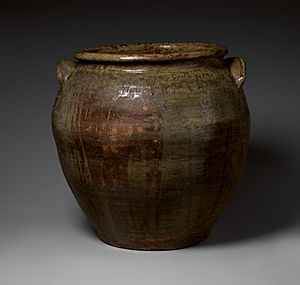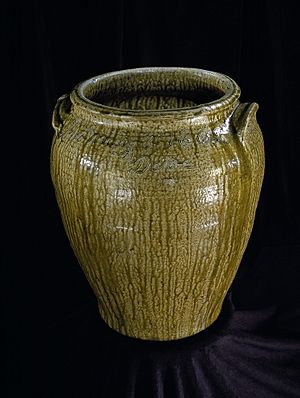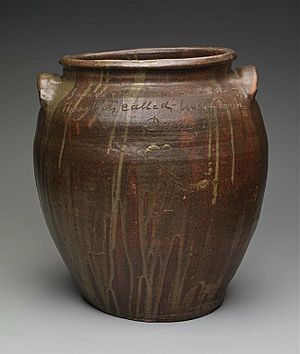David Drake (potter) facts for kids
David Drake (born around 1800 – died in the 1870s), also known as "Dave Pottery" or "Dave the Potter," was an amazing American potter. He was an enslaved African American who lived in Edgefield, South Carolina, for most of his life.
David made special stoneware jugs and jars from the 1820s to the 1870s. He often signed his work "Dave." He was one of the first enslaved potters to write on his creations. This was very unusual because most enslaved people were not allowed to read or write. In fact, it was often against the law for them to learn. David Drake was unique because he wrote short poems, often rhyming, on his pottery, along with his signature.
Contents
Who Was David Drake?
David Drake was likely born in the first half of 1800 on a plantation in South Carolina. He was enslaved by the Drake family. The first official record of him is from June 13, 1818. It describes "a boy about 17 years old country born." "Country born" meant he was born in the United States, not in Africa.
David was first enslaved by Harvey Drake. Harvey Drake owned a large pottery business with his partner, Abner Landrum. David probably learned his pottery skills here. This area was known as Pottersville. It's not clear how David learned to read and write. Some people think Abner Landrum, who published a local newspaper, might have taught him. This was a very risky thing to do. In the early 1800s, many southern states had laws against teaching enslaved people to read and write. South Carolina's Negro Act of 1740 even made it illegal.
At some point, David lost one of his legs. It's thought he might have lost his leg after being punished for writing on his pots.
After Harvey Drake died, David was enslaved by Rev. John Landrum. When Rev. Landrum passed away in 1846, David was sold to Franklin Landrum, Rev. Landrum's son. During this time, David didn't write on his pots.
In 1849, Lewis Miles bought David. This was a very creative time for David. He made many pots with poetry on them. Miles' factory was called 'Stony Bluff.' David's poems became more frequent. He made three in 1857, eight in 1858, and seven in 1859.
After the Civil War, David became a free man. He likely took the last name "Drake" from his first owner. The 1870 United States Census lists him as "David Drake, Turner." It's believed he died in the 1870s, as his name doesn't appear in the 1880 census.
David Drake's Amazing Pottery
David's earliest known pot is from July 12, 1834. The poem on it says:
Put every bit all between
Surely this jar will hold 14
One expert, Jill Beute Koverman, believes David made more than 40,000 pieces in his lifetime. About 20 of his jars have original poems, and 50 more have his signature or other writings. David's jars are often round and wide, like other pottery from his time. He was known for making very large pots. His biggest known jar holds 40 US gallons (150 L) and is 29 inches (74 cm) tall! A special sign of David's work is that his jars are widest at the top.
One famous piece, a 19-inch green pot from August 16, 1857, has this poem:
I wonder where is all my relations
Friendship to all and every nation
David often made jugs that held 25–40 US gallons (95–151 L). He would write short poems or rhyming lines below the rim. Some poems explained the pot's use, like "Put every bit all between / surely this jar will hold 14." Others, like the one above, were about the hardships of slavery. The poem "I wonder where is all my relations / Friendship to all—and every nation" shows David thinking about his family and past. This poem shows his positive spirit even when facing the difficulties of slavery, which often meant losing touch with family.
Many believe David used his writings to express himself, communicate with other enslaved people, and even quietly challenge slavery. Some experts think his poetry was an early act of civil rights because it was forbidden for African Americans to read and write. Many of David's pieces have the initials "LM." This stood for Lewis Miles, who owned the pottery workshop where David worked. Lewis Miles was even mentioned in one of David's poems: "Dave belongs to Mr. Miles / Wher the oven bakes & the pot biles."
His Lasting Legacy
In 2010, a children's book called Dave the Potter: Artist, Poet, Slave was written by Laban Carrick Hill. It tells David's story and shows his amazing pottery skills. The book won an award and was recognized as a top children's book. In 2013, author Andrea Cheng also wrote a book for middle schoolers called Etched in Clay: The Life of Dave, Enslaved Potter and Poet.
During David's lifetime, his pots were worth about 50 cents. Today, they sell for a lot more! Some pieces have sold for over $40,000. In 2012, a butter churn made by David sold for $130,000 at an auction. In 2020, another jar with his writing sold for $369,000.
In 1998, the McKissick Museum at the University of South Carolina held the first exhibition just for David Drake's pottery. In 2010, artist Theaster Gates created an exhibition called Theaster Gates: To Speculate Darkly. It used David's work to explore art and race in African American history. In 2016, the Vero Museum of Art had an exhibition called David Drake: Potter and Poet, which showed 13 of his known pieces.

Where to See His Art
You can find David Drake's work in several museums. Some of the most famous places include:
- The Southern Collection of the Greenville County Museum of Art (Greenville, SC)
- The Smithsonian collection of the National Museum of American History in Washington DC
- The Philadelphia Museum of Art
- The Museum of Fine Arts, Boston
- The McKissick Museum at the University of South Carolina
See also
- List of enslaved people



